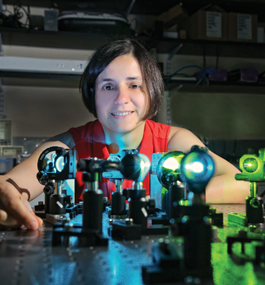Novel Vaccine Research Is a Shot in the Arm

Mike Lovett
Tijana Ivanovic
by Lawrence Goodman
For millions, getting an annual flu shot is the best defense against days or weeks of respiratory misery. But a vaccine works only against the flu strains already infecting humans. Should a new influenza virus emerge, it would sweep through the population before scientists had time to develop an effective vaccine.
Past flu pandemics have killed tens of millions of people. According to the Centers for Disease Control and Prevention, Asian lineage avian influenza A (H7N9), which kills almost 50 percent of the people it infects, has the highest potential to cause a pandemic. So far, humans can contract it only from infected poultry. If it could be transmitted from human to human, the effects would be catastrophic.
With the support of a New Innovator Award from the National Institutes of Health (NIH), assistant professor of biochemistry Tijana Ivanovic will conduct research that may enable us to predict which flu-virus strain will evolve and become capable of being passed from human to human.
The New Innovator Award — part of the NIH’s High-Risk, High-Reward Research program, aimed at encouraging outside-the-box science — is among the most prestigious grants for early-career scientists. Ivanovic will receive $1.5 million over five years.
“This is an opportunity to start projects that are riskier but that have the potential to be transformative,” says Ivanovic, who also won a 2011 L’Oréal USA for Women in Science Fellowship.
Ivanovic will apply her expertise in virology and advanced microscopy to understanding how viruses adapt to target humans. She will use a custom-built total internal reflection fluorescence microscope, capable of observing individual flu viruses in real time, to compare viruses that can be transmitted from person to person to those that can’t. To define the molecular changes that enable the virus to invade human cells, she will focus on a process known as membrane fusion, which occurs when the virus membrane merges with the human-cell membrane to deliver its infectious cargo.
Next, she hopes to identify which viruses are evolving to adapt and infect humans, making it possible to combat the viruses before they acquire the ability to spread widely.
“Right now, we can’t pre-emptively stop a virus from causing a pandemic,” says Ivanovic. “This line of research might put us in the position to make predictions.”
